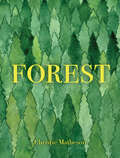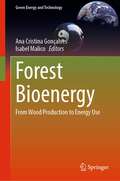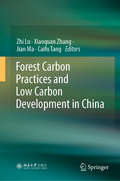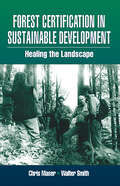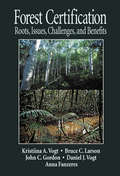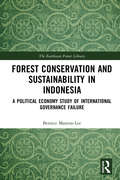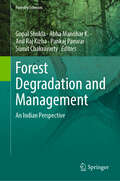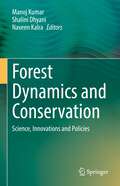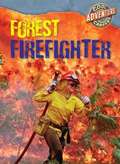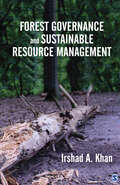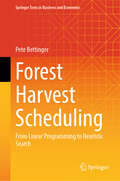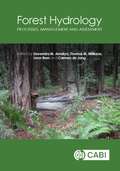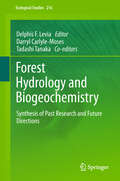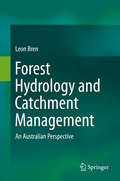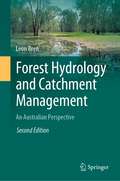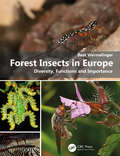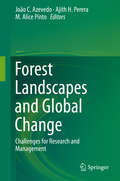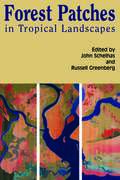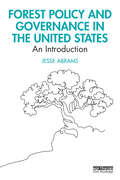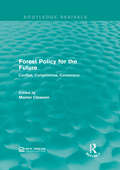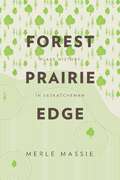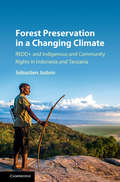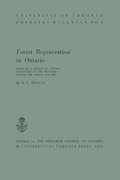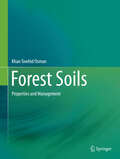- Table View
- List View
Forest
by Christie MathesonA simple introduction to the beauty of forests and the vibrant life within them, from the award-winning author of the acclaimed interactive picture book Tap the Magic Tree.This beautifully illustrated nonfiction children’s picture book begins with a view of the forest at a distance, then zooms in on its fascinating details, including the amazing trees, bright birds, adorable baby animals, and other wonders of nature that inhabit it. The rhythmic text and inviting watercolor illustrations allow curious young readers to observe, explore, and learn what makes forests so special and vitally important.An engaging read-aloud that invites questions and conversation, Forest offers an intriguing introduction to the natural world and encourages little ones to develop a connection with the great outdoors that can last a lifetime. Perfect for any time of year and a beautiful way to celebrate spring, Earth Day, Mother’s Day, or the arrival of a new baby, this endlessly delightful children's nature book includes additional information about forests and what we can do to care for them.
Forest Bioenergy: From Wood Production to Energy Use (Green Energy and Technology)
by Ana Cristina Gonçalves Isabel MalicoThis book is a comprehensive overview of the forest bioenergy, from feedstock production to end products. The book presents the state of the art of forest biomass production, assessment, characterization, and conversion into heat and power. It starts with forest sources of biomass and potential availability. Continues with the characterization of the forest stands and the availability of biomass for energy per stand structure, including stands managed for timber, non-wood products, and energy plantations. It follows with biomass evaluation and monitoring considering data sources, modeling methods, and existing models. are also addressed. After the initial focus on forest biomass production and estimation, this resource is assessed as a feedstock for energy conversion. Not only current, but also emerging biofuels obtained from forest biomass are considered. Established and emerging conversion technologies for the production of bio-heat and bio-power are examined and the impacts of the conversion systems presented.
Forest Carbon Practices and Low Carbon Development in China
by Zhi Lu Jian Ma Xiaoquan Zhang Caifu TangThis is the first book illustrating China’s forest carbon projects. It includes an analysis of the policy and future development trends of China’s forest carbon market and showcases the country’s most representative forest carbon projects. Accordingly, it offers a valuable resource for all policymakers and researchers interested in forest carbon, as well as project developers and engineers involved in forest carbon projects.
Forest Certification in Sustainable Development: Healing the Landscape
by Chris Maser Walter SmithFrom recycled products to organic food, the movement to be "environmentally friendly" is now expanding into the forestry field. Recognizing this impact, Home Depot has committed to giving preference to selling "certified wood," proven to come from forests that meet certain biological and social sustainablility standards. Retailers and vendors can o
Forest Certification: Roots, Issues, Challenges, and Benefits
by Bruce C. Larson John C. Gordon Anna Fanzeres Daniel J. Vogt Kristiina A. VogtForest Certification examines the historical roots of forest certification, the factors that guide the development of protocols, the players involved, the factors determining the customers to be certified, and the benefits of certification. It covers terminology and issues that direct the structure of standards, the similarities between indicators of different human disturbances within the ecosystem/landscape, and certification standards. It documents the roles of human values in the development of assessment protocols and demonstrates how elements should be used to produce non-value based standards.
Forest Conservation and Sustainability in Indonesia: A Political Economy Study of International Governance Failure (The Earthscan Forest Library)
by Bernice Maxton-LeeDespite carefully constructed conservation interventions, deforestation in Indonesia is not being stopped. This book identifies why large-scale international forest conservation has failed to reduce deforestation in Indonesia and considers why key stakeholders have not responded as expected to these conservation interventions. The book maps the history of deforestation in Indonesia in the context of global political economy, exploring the relationship between international trade, the interests and ideology behind global sustainability programmes and the failures of forest conservation in Indonesia. Global economic and political ideologies are shown to have profoundly shaped deforestation. The author argues that the same forces continue to prevent positive outcomes. Case study chapters analyse three major international programmes: Reducing Emissions from Deforestation and Forest Degradation (REDD+), the Norway-Indonesia bilateral partnership, and the Roundtable on Sustainable Palm Oil (RSPO) in Indonesia. The findings provide insight into the failures of global climate change policy and suggest how the book’s theoretical model can be used to analyse other complex environmental problems. The book is a useful reference for students of environmental science and policy, political theory, international relations, development and economics. It will also be of interest to forestry professionals and practitioners working in NGOs.
Forest Degradation and Management: An Indian Perspective (Forestry Sciences #87)
by Gopal Shukla Sumit Chakravarty Pankaj Panwar Abha Manohar K. Anil Raj KizhaForest Degradation and Management - An Indian Perspective provides an overview of the dynamics and challenges surrounding forest degradation in India. It reveals the harmful impacts of human activity on natural resources, ecosystems, and communities, and emphasizes the urgent need for sustainable forest management practices. The book is divided into four parts, each offering a different perspective on forest degradation. Part I presents an overview of forest degradation in India, including a comparative analysis of assessment tools. Part II explores the ecological impacts of forest degradation on ecosystems. Part III is dedicated to societal aspects, examining the consequences of human activity such as cultivation, eco-tourism, resource utilization, and deforestation, while also analyzing the impact of forest degradation on forest-dependent communities. Part IV focuses on mitigation strategies, highlighting the role of protected areas, governance, policies, and participatory approaches. This volume within the book series Forestry Sciences is an invaluable resource for students, researchers, policymakers, and conservationists seeking to tackle the complex challenges of forest degradation. It provides knowledge and practical insights to inform decision-making processes, guide sustainable forest management strategies, and promote responsible land use practices.
Forest Dynamics and Conservation: Science, Innovations and Policies
by Manoj Kumar Shalini Dhyani Naveen KalraThis book unveils forestry science and its policy and management that connect past and present understanding of forests. The aggregated knowledge is presented to cover the approaches adopted in studying forest structure, its growth, functioning, and degradation, especially in the context of the surrounding environment. The application of advance computation, instrumentation, and modelling has been elaborated in various chapters.Forest ecosystems are rapidly changing due to forest fires, deforestation, urbanization, climate change, and other natural and anthropogenic drivers. Understanding the dynamics of forest ecosystems requires contemporary methods and measures, utilizing modern tools and big data for developing effective conservation plans. The book also covers discussion on policies for sustainable forestry, agroforestry, environmental governance, socio-ecology, nature-based solutions, and management implication. It is suitable for a wide range of readers working in the field of scientific forestry, policy making, and forest management. In addition, it is a useful material for postgraduate and research students of forestry sciences.
Forest Firefighter (Cool Adventure Careers)
by William David ThomasThe first group of titles in an ongoing series introduces students to six amazing adventure careers. Geared for reluctant readers in upper elementary school and above, each high-interest title combines easy-to-follow text with engagin on-the-job photos to spark students' interest in reading and career exploration. Each book is filled with descriptive information about the career, along with the skills and requirements needed to pursue a job in the profiled field.
Forest Governance and Sustainable Resource Management
by Irshad A. KhanForest Governance and Sustainable Resource Management vividly presents the current state of management and governance of forests and other natural resources in India. It focuses on the substantial underperformance and need to ensure effective implementation of the national forest policy to arrest further depletion of India’s rapidly declining forest cover. The book extensively covers the history of forestry in India, the various forest policies, the legal and management frameworks, the various international conventions and protocols for dealing with climate change and how effective forest management can enable their implementation. It recommends various strategic, implementational and governance reforms to deal effectively with the current situation. A highlight of this book is its extensive coverage of the Reducing Emissions from Deforestation and Forest Degradation in Developing Countries (REDD+), a climate change mitigation solution adopted by the United Nations, and India’s state of readiness in implementing it. The book suggests that foresters need to overcome their siege mentality and instead work towards empowering themselves to play a more proactive role in saving India’s forest resources.
Forest Harvest Scheduling: From Linear Programming to Heuristic Search (Springer Texts in Business and Economics)
by Pete BettingerThis book provides a synthesis of methods that have been used in both practice and research to develop forest harvest schedules (plans of action) and to assess alternative policy scenarios. Beginning with exact mathematical methods (linear, mixed integer, and goal programming), the book provides a brief history of their conception, followed by an approachable description of the processes commonly employed to search a solution space for the optimal solution to a problem. Hill-climbing, random search, and binary search processes are then described as relatively simple alternatives to the exact methods. Heuristic search processes (threshold accepting, simulated annealing, tabu search, and genetic algorithms) are then described as semi-rational, biased alternatives to solving forest harvest scheduling problems. The closing remarks of the book provide context for the use of forest harvest scheduling in addressing today's contemporary forest management issues. In addition to a set of common-sense principles that are introduced throughout the book, provided in the book is a fifty-question exam associated with the content introduced.
Forest Hydrology
by Devendra M. Amatya Thomas M. Williams Leon Bren Carmen JongForests cover approximately 26% of the world's land surface area and represent a distinct biotic community. They interact with water and soil in a variety of ways, providing canopy surfaces which trap precipitation and allow evaporation back into the atmosphere, thus regulating how much water reaches the forest floor as through fall, as well as pull water from the soil for transpiration. The discipline "forest hydrology" has been developed throughout the 20th century. During that time human intervention in natural landscapes has increased, and land use and management practices have intensified. This book: - Presents cutting edge thinking and assessments in forest hydrology across all latitudes and terrains, including state-of-the-art modelling techniques and methodologies - Describes the latest challenges facing forest hydrology, such as increased occurrence of disturbance, due to extreme floods, drought, disease, and fire, potentially caused by climate change - Is written by an internationally renowned team of scientists, engineers, and managers to give a well-rounded review of the subject The book will be useful for graduate students, professionals, land managers, practitioners, and researchers with a good understanding of the basic principles of hydrology and hydrologic processes.
Forest Hydrology and Biogeochemistry
by Darryl Carlyle-Moses Delphis F. Levia Tadashi TanakaThis international rigorously peer-reviewed volume critically synthesizes current knowledge in forest hydrology and biogeochemistry. It is a one-stop comprehensive reference tool for researchers and practitioners in the fields of hydrology, biogeoscience, ecology, forestry, boundary-layer meteorology, and geography. Following an introductory chapter tracing the historical roots of the subject, the book is divided into the following main sections: · Sampling and Novel Approaches · Forest Hydrology and Biogeochemistry by Ecoregion and Forest Type · Hydrologic and Biogeochemical Fluxes from the Canopy to the Phreatic Surface · Hydrologic and Biogeochemical Fluxes in Forest Ecosystems: Effects of Time, Stressors, and Humans The volume concludes with a final chapter that reflects on the current state of knowledge and identifies some areas in need of further research.
Forest Hydrology and Catchment Management
by Leon BrenFor the last three centuries forests have been recognised as providing the best water catchments and valued for their sustained output of high quality water. In Australia, work which was commenced fifty years ago has come to fruition and is providing new information on forest hydrology issues. The book focusses on the issues of small streams, including catchment definition, slope, hydrograph formation, water quality measurement, and annual water yield. The world-wide management issues of sustaining riparian forests are examined, using the River Murray forests as an example. Finally a large amount of information is drawn together to examine the management of forested catchments for water supplies. This book presents an incisive, disciplined, quantitative approach to dealing with forest hydrology matters. Although world-wide in application, the book particularly draws on Australian studies. It is written with the needs of students and forest practitioners in mind.
Forest Hydrology and Catchment Management: An Australian Perspective
by Leon BrenThis book provides scientific evidence to underline the notion that forests offer the most reliable water catchments in the natural environment. The unique Australian ecosystem provides valuable information on the water yields and hydro-ecology of forests. Insights can be transferred to other climate zones and conditions. In this second edition, the author puts a particular focus on the most prominent challenges of our time, in relation to water management. Ground salinity, climate change, and droughts have all been newly added to this updated edition. One of the most important concepts is highlighting the accumulated contribution of smaller catchments and minor streams. Finally, readers will also get information on the economic dimension of water management. With its incisive, disciplined, and quantitative (and occasionally humorous) approach, this book helps scientists, students, and regulators to understand water-driven conflicts and offers guidance on management.
Forest Insects in Europe: Diversity, Functions and Importance
by Beat WermelingerForest insects play important roles ecologically and economically. They pollinate plants, decompose dead plant and animal tissue, provide food for vertebrates, regulate pest organisms and shape entire landscapes. Some are considered pests, while others provide usable products. Introduced species may become invasive, while the survival of others is threatened. Forest Insects in Europe: Diversity, Functions and Importance has been written not only with professional entomologists in mind, but also for nature lovers generally. The descriptions of the various roles insects play in forest ecosystems are intended to be easily comprehensible, but still scientific. The book is richly illustrated with attractive photos and contains 580 fascinating colour images of more than 300 different insect and spider species. The German edition was awarded the Prix Moulines by the Swiss Entomological Society in 2019.
Forest Landscapes and Global Change
by Ajith H. Perera João C. Azevedo M. Alice PintoClimate change, urban sprawl, abandonment of agriculture, intensification of forestry and agriculture, changes in energy generation and use, expansion of infrastructure networks, habitat destruction and degradation, and other drivers of change occur at increasing rates. They affect patterns and processes in forest landscapes, and modify ecosystem services derived from those ecosystems. Consequently, rapidly changing landscapes present many new challenges to scientists and managers. While it is not uncommon to encounter the terms "global change" and "landscape" together in the ecological literature, a global analyses of drivers of change in forest landscapes, and their ecological consequences have not been addressed adequately. That is the goal of this volume: an exploration of the state of knowledge of global changes in forested landscapes with emphasis on causes and effects, and challenges faced by researchers and land managers. Initial chapters identify and describe major agents of landscape change: climate, fire, and human activities. The next series of chapters address implications of changes on ecosystem services, biodiversity conservation and carbon flux. A chapter that describes methodologies of detecting and monitoring landscape changes is presented followed by chapter that highlights the many challenges forest landscape managers face amidst of global change. Finally, we present a summary and a synthesis of the main points presented in the book. Each chapter will contain the individual research experiences of chapter authors, augmented by review and synthesis of global scientific literature on relevant topics, as well as critical input from multiple peer reviewers.
Forest Management for Timber Production and Climate Change Mitigation: Linking Dynamics of Carbon Cycle in Ecosystem Management (Managing Forest Ecosystems #44)
by Seppo KellomäkiThis book introduces the complex world of carbon dynamics within forest ecosystems, particularly in boreal zones, while also incorporating findings from selected temperate areas. It explores how these dynamics are influenced by management strategies and operations, providing a comprehensive understanding of how forests can be managed to enhance carbon uptake and thus, mitigate climate change. Divided into five parts, the volume begins by addressing the characteristics of global and boreal forests and their contribution to carbon storage. The following sections explore carbon dynamics in both natural and managed forests, including their impact on forest succession. The text also examines how management practices affect carbon dynamics, tree growth, and carbon stocks. Strategies to mitigate climate change through forest management, including the management of soil carbon and reforestation efforts are discussed. Finally, topics such as pre-commercial management, commercial thinning, and forest fertilization and their roles in managing boreal forest ecosystems for carbon sequestration and climate benefits are addressed. Aimed at professionals, researchers, and students in forestry, environmental science, and climate change studies, this book provides valuable insights into developing management strategies that enhance carbon uptake and accumulation in forest ecosystems. Readers will gain a comprehensive understanding of how forest management can contribute to climate change mitigation. It is an essential resource for anyone interested in sustainable forestry practices.
Forest Patches in Tropical Landscapes
by John Schelhas Russell S. Greenberg"While tropical forests are being cleared at an alarming rate, the clearing is rarely complete and is often not permanent. A considerable amount of tropical forest exists as remnants that have significant value both for the conservation of biological diversity and for meeting the needs of local people.This volume brings together world-renowned scientists and conservationists to address the biological and socio-economic value of forest remnants and to examine practical efforts to conserve those remnants. An outgrowth of a year-long study by the policy program at the Smithsonian Migratory Bird Center, Forest Patches in Tropical Landscapes provides a broad overview of theory and practice, and will help foster both interdisciplinary research and more effective approaches to tropical conservation and development.
Forest Policy and Governance in the United States: An Introduction
by Jesse AbramsThis new textbook provides an up-to-date and comprehensive introduction to both the policy background and contemporary governance of forests in the United States. Starting with a history of the development of forest policies and conservation agencies, the book then explores the diversity of forest owners, users, and uses and examines emerging approaches to forest governance that cross traditional jurisdictional and property boundaries. It tackles key contemporary issues such as the forest water nexus, the conservation of threatened and endangered species, and the challenges of managing fire, insect, and disease dynamics under a changing climate. Key focal areas include the emergence of collaborative approaches to forest governance, community forest relationships, changes to corporate timberland ownership, and contemporary governance mechanisms such as certification and payments for ecosystem services. This text raises the "big questions" about the distribution of rights and responsibilities in forest management, the tensions between equity and efficiency, and how to sustain a diversity of forest values under the pressures of ecological and social complexity. Written in an accessible and engaging manner, this textbook provides a timely synthesis of both the foundations and current trends and issues in forest policy and governance in the United States with a strong emphasis on illustrative real-world cases. Forest Policy and Governance in the United States is essential reading for students in forest and natural resource policy courses and will be of great use to students in environmental governance courses. It will also be of interest to policymakers and professionals working in forest conservation and in the forest industry.
Forest Policy for the Future: Conflict, Compromise, Consensus (Routledge Revivals)
by Marion ClawsonThe use and management of forests in the United States, especially the public owned ones, have been the focus of considerable controversy. First published in 1974, this volume, a collection of papers originally delivered at the RFF Forest Policy Forum, explores alternative forest management programmes to see what is biologically, economically, socially and politically possible. This title is a valuable resource for students interested in environmental studies, as well as for policy makers.
Forest Prairie Edge: Place History in Saskatchewan
by Merle MassieSaskatchewan is the anchor and epitome of the ‘prairie’ provinces, even though half of the province is covered by boreal forest. The Canadian penchant for dividing this vast country into easily-understood ‘regions’ has reduced the Saskatchewan identity to its southern prairie denominator and has distorted cultural and historical interpretations to favor the prairie south. Forest Prairie Edge is a deep-time investigation of the edge land, or ecotone, between the open prairies and boreal forest region of Saskatchewan. Ecotones are transitions from one landscape to another, where social, economic, and cultural practices of different landscapes are blended. Using place history and edge theory, Massie considers the role and importance of the edge ecotone in building a diverse social and economic past that contradicts traditional “prairie” narratives around settlement, economic development, and culture. She offers a refreshing new perspective that overturns long-held assumptions of the prairies and the Canadian west.
Forest Preservation in a Changing Climate: REDD+ and Indigenous and Community Rights in Indonesia and Tanzania
by Sébastien JodoinThis book provides a comprehensive socio-legal examination of how global efforts to fight climate change by reducing carbon emissions in the forestry sector (known as REDD+) have affected the rights of Indigenous Peoples and local communities in developing countries. Grounded in extensive qualitative empirical research conducted globally, the book shows that the transnational legal process for REDD+ has created both serious challenges and unexpected opportunities for the recognition and protection of indigenous and community rights. It reveals that the pursuit of REDD+ has resulted in important variations in how human rights standards are understood and applied across multiple sites of law in the field of REDD+, with mixed results for Indigenous Peoples and local communities in Indonesia and Tanzania. With its original findings, rigourous research design, and interdisciplinary analytical framework, this book will make a valuable contribution to the study of transnational legal processes in a globalizing world. This title is also available as Open Access. Explores the opportunities as well as the challenges that REDD+ has created for the protection of human rights in developing countries. Provides comprehensive analysis of the implications of REDD+ for the rights of Indigenous Peoples and local communities. Original findings developed through extensive fieldwork provide new insights for those working on the intersections of REDD+ and rights.
Forest Regeneration in Ontario: Based on a Review of Surveys Conducted in the Province during the Period 1918-1951 (University of Toronto Forestry Bulletin #no. 2)
by R. C. HosieThis volume reports all the information presently available from the fifty-seven regeneration surveys carried out to the present by government and private agencies within the Province of Ontario. <P><P>It presents a general view of the nature of tree reproduction on cut-over forest land, followed by an analysis of the procedure in conducting and reporting regeneration surveys, and conclusions and recommendations for the conducting of future surveys.
Forest Soils
by Khan Towhid OsmanForest soil characteristics are not only unique but their interpretation also differs from cropland soils. Just as there are diverse forest types, there are many soil variants that need different management. Today, forest plantations are being intensively managed for profitable timber, pulpwood and energy production. Site selection, species selection, site productivity evaluation, silvicultural treatments, and soil amendments need crucial soil information. This book provides a comprehensive overview of the physical, chemical and biological properties of forest soils and their implications on forest vegetation. Topics discussed include: major forest types of the world and their associated soils; forest biomass and nutrient dynamics; organic matter turnover and nutrient recycling; forest soil disturbance; forest soil and climate change; and forest soil management and silvicultural treatments.
